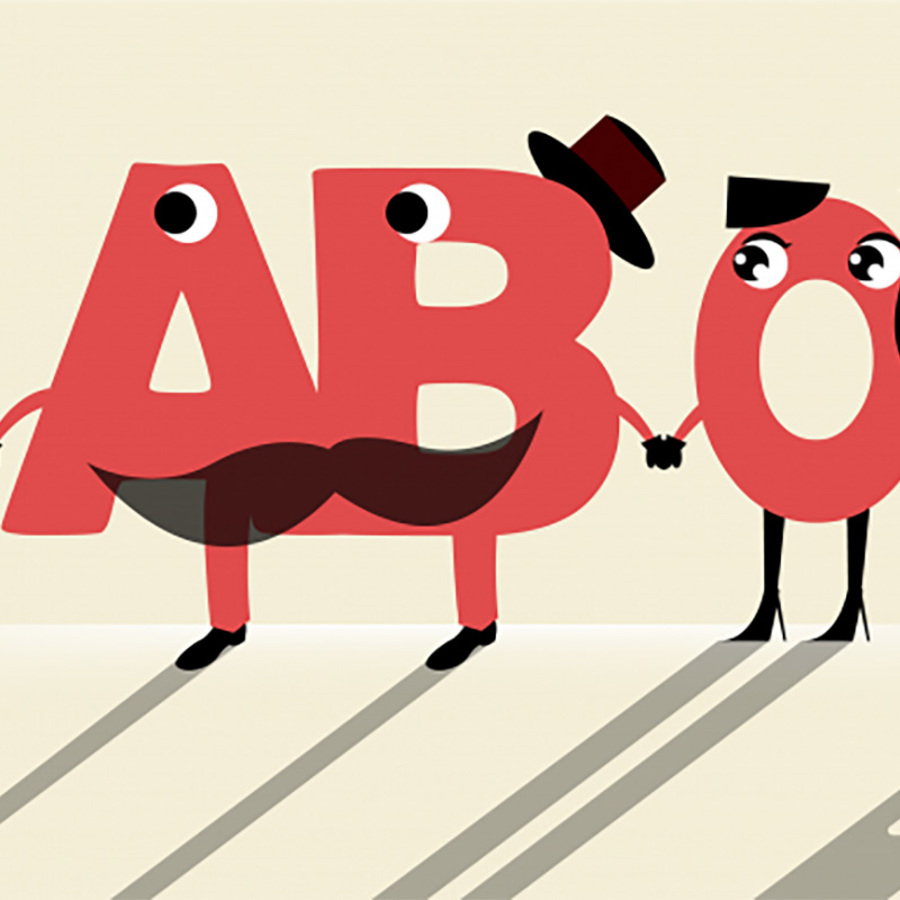
Does a child usually have the same blood type as one of their parents?
December 6, 2016

- Related Topics:
- Blood type,
- ABO blood type,
- Punnett squares,
- Common questions,
- Genes to proteins,
- Genotype and phenotype
A curious adult from Michigan asks:
“In general, does a child usually have the same blood type as one of their parent’s blood type?”
While a child could have the same blood type as one of his/her parents, it doesn’t always happen that way. For example, parents with AB and O blood types can either have children with blood type A or blood type B. These two types are definitely different than parents’ blood types!
But two O parents, for example, will pretty much always have O kids. They will match both parents.
As you can see, sometimes kids’ blood types match and sometimes they don’t. There are certain genetics “rules” that allowed me to get to this answer, which I break down for you below.
Like any good rules, there are exceptions. But these rule-breaker situations are very rare. Almost all cases follow a set of genetics rules based on how genes are passed down from parent to child.
One Gene Can Lead to Four Different Blood Types
Let’s start with DNA. DNA has the instructions for making a living thing. So your DNA has instructions for making you.
Each specific instruction for a small part of you is called a gene. As humans, we all have the same 20,000 or so genes. What makes us different are the different versions of these genes.
For example, we all have the blood type gene, ABO. What gives us different blood types is that this gene comes in three different versions: A, B, and O.
In a simple world, the three versions would give three blood types and a child would have one of the blood types of the parents. But we don’t live in a simple world, now, do we?
There’s one more thing we need to know about our genes: we have two copies of most of them. We get one copy from our mom and one from our dad. Each of your parents have two copies of each of their genes, and they each pass one down to you.
Can you start to see how this may complicate things?
Since we get these genes from our parents, it is common to share certain traits with our parents, like blood type. But like I said at the start, that’s not always the case.
Because we have two copies of the blood type gene and there are three possible versions of this gene, there are six possible combinations. Officially complicated! They are:

These are called blood type genotypes. They are all of the possible combinations of the two gene versions together.
Ok so we have six combinations and only four blood types. Lets see why that is.
Gene-Protein Relationship
I told you there are all these different genes and that they come in versions. But what exactly do they do and what is different about them?
Genes are the instructions for proteins. And different gene versions make different versions of a protein.
So the A version of the ABO genes makes the “A” version of a protein, the B version a B version of a protein and importantly, for our discussion, the O version doesn’t make either.
Your blood type is determined by which of these proteins you actually make. This is why there are four different blood types.
Remember our 6 genetic combinations, or genotypes? Well, since O means no protein, here is how they break down into four blood types, or phenotypes:
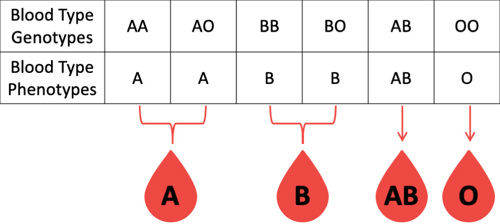
So AO is A blood type because it only makes the A protein version. Same thing with BO except it is blood type B because it only makes the B version. The O contributes nothing. Except, perhaps, in the next generation.
How to Figure Out a Child’s Possible Blood Type
Ok so now we have everything we need to predict what blood type a child will likely have given two parents. All we need to know are the parents’ blood genotypes.
Using a Punnett square is a great way to figure out a child’s possible blood types based on the parents’ blood types. A Punnett square is just a diagram that helps to organize all of the genes to figure out the likelihood for a certain combination of genes.
First, put the two ABO gene versions from one parent along the top like this:
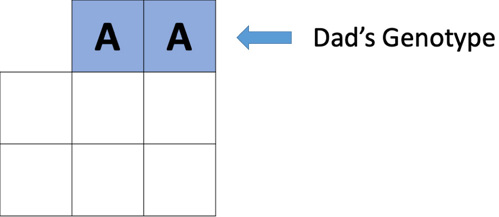
Here we made dad AA, which is his genotype, or his two gene versions together. He could also be AO and still have an A blood type, like we saw above.
To keep track of things, the A blood type will be shaded blue.
Then, let’s say Mom is AA too. We put her genotype in these two squares (marked with the arrow).
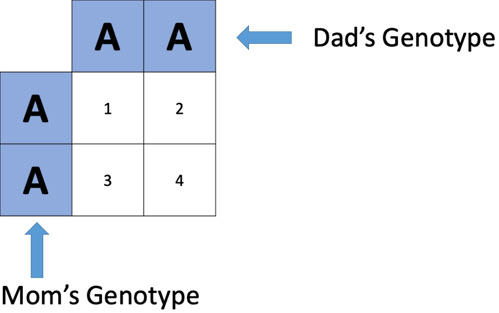
If both parents are AA blood type, then that’s a rather simple Punnett square and the child can only have the same blood type as mom and dad. Let’s work through the Punnett square to see how.
For this to work, remember that we only get one copy of a gene from mom and one from dad. So, for example, dad will pass either his first A or his second A but not both. While this isn’t very important in this example, because the two genes are the same version, you’ll see how it is in later examples!
So let’s do box 1 first. Above box 1 is dad’s first A and to the left is mom’s first A. We combine them to get the first possible combination.
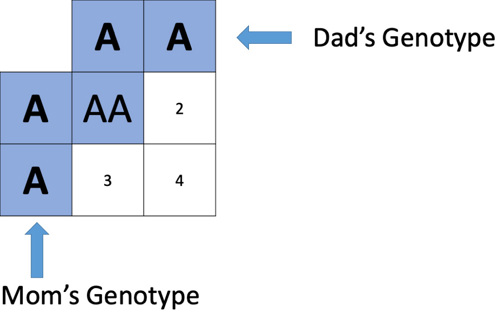
If you continue doing the same in boxes 2-4, you get this finished pedigree.
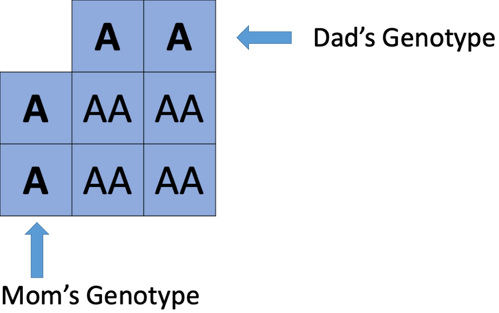
As you can see by all of the blue boxes, the child’s only possible blood type combination is AA, just like the parents. So 100% of their kids will be AA.
Now let’s see what we get with two AO parents. Just like before, we are starting with two parents with A blood type.
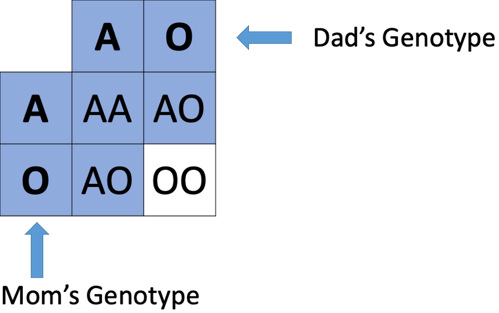
But now, the Punnett square looks different!
Even though both parents still have blood type A, Dad can pass on either his A or his O gene version. Mom can also either pass on her A or her O.
Because of this, you can see that there’s 1 in 4 or 25% chance for a child to have OO, or blood type O.
How did I get a 1 in 4 chance? Let me show you!
The child can have 4 possible genotypes that I’ve shaded here in gray so you can see what I’m talking about.
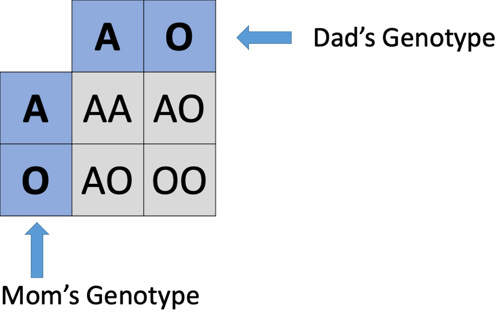
Yes, AO is there twice, but they still count as separate possibilities.
Out of those 4, three combinations give blood type A, I’ve shaded those in lighter blue below.
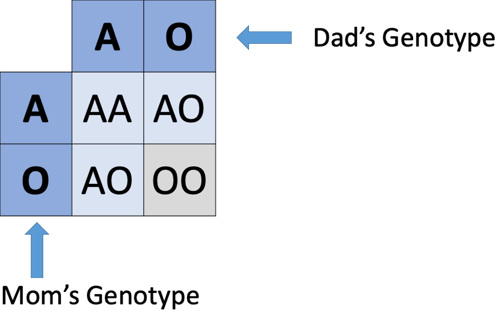
One combination, OO, gives blood type O.
So there’s a 1 out of 4, or 25% chance, that the child will have blood type O and 3 out of 4, or 75% chance that the child will have blood type A.
This example shows the importance of knowing the parents’ genotypes to figure out a child’s possible blood type. Just knowing “type A” isn’t enough information. You need to know the genotype, either AA or AO.
Let’s try one more!
What if the parents were AB and O blood type? You can start by placing the genotypes of the two parents in the correct squares.
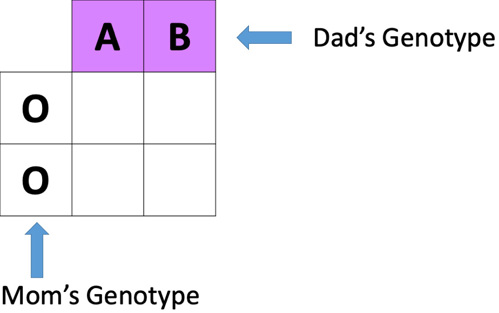
Here the AB blood type is shown in purple.
Now we combine the blood type letters like we did before.
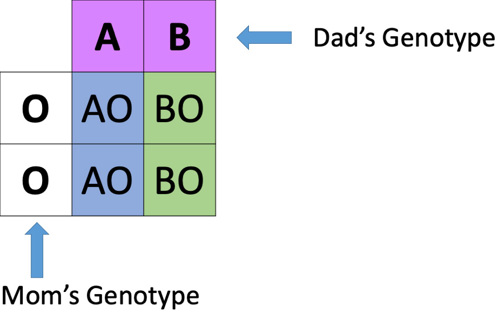
Now, you can see a situation where the child’s possible blood type combos are unlike either of the parents. The child of an AB dad and a OO mom could either be AO (blood type A) or BO (blood type B).
All possibilities
You could do a Punnett square for every possible combination of parent blood types. Or, you could just use a helpful chart like this one:

Hopefully you can see how it’s almost impossible to say that in general, children have the same blood type as one of the parents! But using genetics knowledge and Punnett squares, we can figure out the possibilities for a child’s blood type based on the parents’ blood types.

Author: Danielle Dondanville
When this answer was published in 2016, Danielle was a student in the Stanford MS Program in Human Genetics and Genetic Counseling. Danielle wrote this answer while participating in the Stanford at The Tech program.
 Skip Navigation
Skip Navigation
